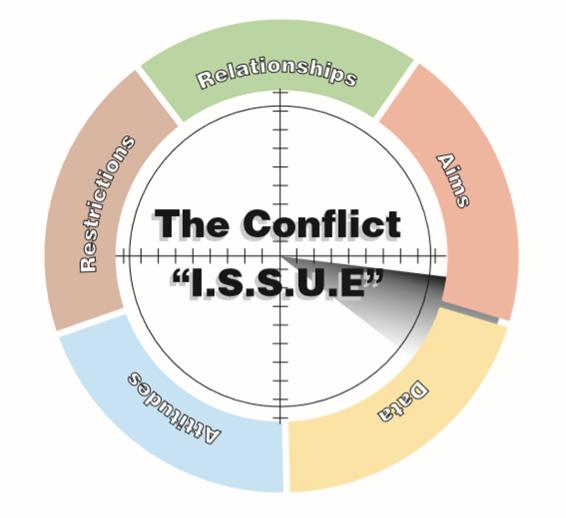Many articles on conflict-handling focus on one of two subjects:
- The conflict itself – what it is, how it has arisen and even who is most at fault
- The best approach or even style to best handle or resolve the conflict.
While both of these aspects of any conflict situation are important, they miss out on another key subject area and one which should often be considered first – the context within which the conflict has arisen in the first place. In other words, we cannot consider a conflict situation in isolation from the circumstances in which it has occurred, and the key to its resolution may well lie as much in this contextual realm as it does in appreciating the conflict issue and the people involved in the dispute.
Although we can adopt a general strategy to think about a conflict’s context, one useful model, developed by the author of this article, may be helpful to consider a number of possibilities. This is called the “RADAR” model – being both an acronym and also providing the image of putting a conflict issue or situation on a radar screen by way of analogy, in order to determine where it may be coming from.
In this case the RADAR model refers to the five contextual categories of relationships, aims, data, attitudes, and restrictions. When you use the RADAR method, the simple idea is that you are scanning the environment, or context, to see how the conflict shows up on our own, personal “radar” screen. A graphical illustration of the RADAR model is shown below:
 Let’s look at each of these five contextual categories in a little more detail.
Let’s look at each of these five contextual categories in a little more detail.
The Context of RELATIONSHIPS Conflicts
Relationship issues often have the greatest influence on disputes and can lead to an ever increasing spiral of potentially destructive behaviour in many cases. In almost all conflict situations, a relatively stable and balanced relationship between the two parties is needed to ensure free expression and a climate in which both parties can be heard. In some cases a new or different relationship for one of the parties (known or unknown) can act to destabilize the one between the disputants. To resolve a dispute, all parties should therefore openly talk about relationships which may be influential on possible outcomes.
The Context of AIMS Conflicts
Conflicts about personal aims are usually caused by the strongly held and generally incompatible goals or objectives of the parties involved. In other words, they arise when one or more of the parties believe that, in order to satisfy his or her aims, the goals of another person must be sacrificed or put to one side. Problems like this may occur over substantive issues such as status, resources, procedures and rules, or perception of issues like honesty, trust, fairness, respect, etc. To resolve a dispute, all parties must therefore openly declare their goals so they can be properly understood and the potential for possible compromise explored.
The Context of DATA Conflicts
Data conflicts arise when people don’t have the information needed to make an informed decision or are misinformed in some way. It can also arise when two parties disagree on what information is relevant, or interpret information differently. Some data conflicts are caused by a lack of communication and therefore can be easily resolved with a deliberate attempt to share information. Other data conflicts may be over real differences associated with how data is gathered, interpreted or communicated. Most data conflicts will have information solutions. To resolve a dispute, all parties should therefore seek to clarify what data conflicts may exist and talk about them to ensure that discussions are “on the same page”.
The Context of ATTITUDES Conflicts
Attitude conflicts typically arise as a result of real or perceived incompatibility in values or beliefs. Differing values do not necessarily lead to conflict but disputes can occur when people attempt to force their own beliefs or attitudes on others, or do not allow for different views. Spending time trying to discover shared values or beliefs can greatly assist the conflict resolution process, mainly because it is easier to deal with different attitudes when one or more shared beliefs has been established. To resolve a dispute when attitudes appear to be in conflict, all parties should describe a given belief which appears to be in dispute and discuss why the view is held so that full balanced exploration can occur.
The Context of RESTRICTIONS Conflicts
Conflicts that are restricted or constrained in some way are usually caused by forces external to the people in dispute. Limited authority, geographic constraints (distance or proximity), time (too little or too much), insufficient resources, organisational changes, etc. can all make conflict appear like a crisis because there is often nowhere to go that does not seem to be blocked or restricted by external forces. It can be helpful to assist both sides in a dispute to appreciate the external forces and constraints bearing upon them. By pointing out that a conflict is heavily influenced or affected by an external source it can help both parties to come together to address the issue, and reduce the personal conflict.
Summary
By evaluating the context of a particular conflict according to the five RADAR categories each time we have to deal with conflict, we can start to recognize the possible causes of a conflict or at least its general background, and start to design a resolution strategy, approach or tactics that are likely to have a higher probability of success or a “win-win” outcome. We then have a much more solid foundation upon which to both analyze the detail of the conflict itself and what approach or style of communication is likely to work best.
Dr. Jon Warner is a prolific author, management consultant and executive coach with over 25 years experience. He has an MBA and a PhD in Organizational Psychology. Jon can be reach at OptimalJon@gmail.com
Colin is the Director of ResourceZone. He has 30 years of ministry experience as a pastor, college lecturer and consultant/coach to consultants, denominational leaders and local church pastors. He can be reached at info.blog@resourcezone.com.au
Related Resources
- Conflict Style Assessment (Hard Copy) – Ministry Specific Resource
- Conflict Resolution: Training Handout (PDF)
- Conflict Resolution: Skill Builder Booklet – Ministry Specific Resource (PDF)
- Conflict Management Storyboard – Ministry Specific Resource (PDF)
- Conflict Management: Coaching Guide with Storyboard – Ministry Specific Resource (PDF)





